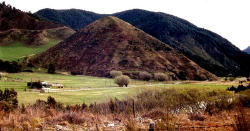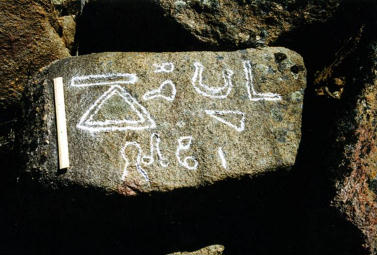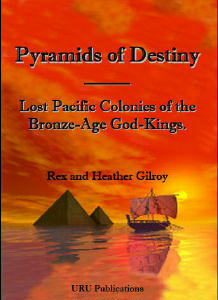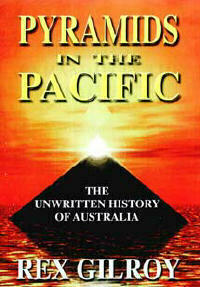
| Pyramids of Destiny – Lost Pacific Colonies of the Bronze-Age God-Kings |
 |
This ancient Egyptian inscription, engraved upon a granite block, was found by Rex Gilroy in a secluded Moonbi Range, New South Wales gully in May 1991. The inscription lies amid the ruins of an apparent collapsed temple. The inscription reads: “the exalted one of Heaven. His works are here to keep safe”. Photo copyright © Rex Gilroy 2008. |
Pyramids of Destiny – Lost Pacific Colonies of the Bronze-Age God-Kings
by Rex & Heather Gilroy
Copyright
© Rex Gilroy 2009
| “Australian history is almost always picturesque; indeed it is so curious and strange, that it is itself the chiefest novelty the country has to offer, and so it pushes all other novelties into second and third place. It does not read like history but like the most beautiful lies. Mark Twain: Following the Equator [1891] |
”Every truth passes through three stages before it is recognised. In the first, it is ridiculed. In the second, it is opposed. In the third, it is regarded as self evident.” Arthur Schopenhauer [1788-1860] |
Part Four.
Lost Mining Kingdoms of New South Wales.
Chapter Thirty.
The Celto-Phoenician God-Kings of New England.If the ancient mineral-seekers entered the Barwon River where it meets the Culgoa and Bogan Rivers as they join the Darling and sailing on further, entered the Castlereagh River, they could have followed it through the mineral-rich areas of Coonamble and Gilgandra to the north of Dubbo.
However, once a vessel or two found the mouth of the Namoi River, which branches off the Barwon where Walgett now stands, they would have begun uncovering the rich fields of minerals and gemstones still to be found in regions such as modern Narrabri and Gunnedah, before it becomes the Peel River in the Carroll Gap area, to flow on past Tamworth and Nundle before fading away in the vicinity of Ben Halls Gap National Park.
Once more, readers who see these water courses today probably cannot see how ancient trireme-size ships could have ventured along them. Yet they see these rivers in their modern forms as often almost dried up water courses, whereas in the age with which we are dealing, these river systems were wide, deep permanent watery highways, by which the ancient mariners were able to find rich deposits at just about every locality in which they established temporary camps along the way.
And, once the rich deposits of precious metals and gemstones of the Tamworth and Nundle areas were uncovered, this led to mass migrations from the more populated settlements further down the Darling-Murray Rivers, and the establishment of large mining colonies in the newly discovered mineral-bearing localities. And those intrepid explorers who moved overland after negotiating the Moonbi Gap would have discovered the rich gold fields of the Kentucky, Uralla and Armidale areas of the Moonbi Range.
In those times, the rivers of New England, like those elsewhere in New South Wales, often fed large lake systems, and the New England district supported many of these Pleistocene survivors, which today are now long dried up. One of these was a massive lake that stretched from what is now the western fringe of Tamworth’s city shopping area, southward into Timbumburi and northwards into Attunga extending westwards to Gunnedah, penetrating many gullies to north and south of its waters, so as to cover many hundreds of square kilometres, being at least 15-20 metres deep in places.
In the nine years that I tried to establish a natural history museum at a Timbumburi location, between 1991 and 2000, Heather and I were able to carry out a considerable amount of field researches around the former shorelines of this and other great [former] lakes of the New England district. These searches led to a large number of inscribed stones being uncovered, pointing to long-term colonisation for mining purposes hereabouts, and in the Moonbi Range we would not only uncover the remains of a vast Uru presence, but rock script evidence of their eventual integration with the newcomers.
From our combined efforts over the years, we have come to the conclusion that a major settlement eventually grew from a collection of smaller encampments scattered between Tamworth and Nundle, which in turn became a city. Here a local ruling class emerged to create a great northern kingdom, independent of that of the Central Western districts and other lands further south; the seat of government and place of residence of these Pharaohs being in the Nundle area.
From the mass of rock scripts gathered in the New England region, it can be seen that, aside from the Egyptians, Libyans and Phoenicians that there was a considerable Celtic presence here; and as the Celts of Iberia joined the Phoenicians and Egyptians on their mining expeditions into the Indian Ocean to lands beyond around 1500BC, then this great northern New South Wales colony appears to date from about that time.
Of course there were probably pre-Celtic expeditions into the New England district, in the times before the gradual development of the great kingdom. We still have much to learn about the New England operations, as our recent discoveries at Barraba demonstrate, but more of that anon…
Entering the Gwydir River from the Barwon, the first of the Bronze-Age explorers to sail this waterway would have passed through the Moree area eastwards for some distance, before the river turns roughly south-east to flow through Bingara, then on through Bundarra to trickle away near Uralla. An offshoot of the Gwydir, the Horton River, which begins at Sadlers Flat, winds its way south past the high escarpment of the mountain country of Upper Horton, vanishing south-east of Cobbadah.The Upper Horton region has lately become the scene of a major Phoenician mining settlement discovery of Heather and I. A rich gold and copper region, it has also produced rubies. It is certain that a major settlement was established on the Gwydir near Moree, as from the discovery by us of a ruined temple dedicated to Tanith, the Phoenician Earth-Mother Goddess in March 1994. We shall return to the Moree district later.
When we first established ourselves in the Tamworth district we actually rented a remote farmhouse up in the Moonbi Range. This was a lucky choice as things worked out. Hidden deep in the range, I spent months exploring these eerie hills, much of which are covered in granite outcrops and dense gum forests. Hereabouts I came upon one ancient Uru megalithic site after another, upon which I spent months measuring and photographing.
However, these sites yielded up many rock inscriptions which, together with the hundreds of square kilometres of structures that we were to turn up in the years ahead, showed this entire region to have been a massive culture centre of this race. I also uncovered remains of apparent ancient open-cut gold and copper mining operations. Quartz [gold-bearing] reefs cover these hills, and there are also undoubted ancient road outlines to be found leading to and from these sites, with huge gums, hundreds of years old in many cases, growing up through them, attesting to the pre-British age of these mining sites.
Yet it would appear that Egypto-Phoenician colonists and their allies were not the first to mine the New England riches, for Heather and I discovered a crumbling Sumerian-style ziggurat, carved out of a 60m tall hill near Armidale [see Chapter 7] and more evidence of a Sumerian presence in this region must still await discovery.
Main Book Index | Mysterious Australia Homepage | URU Homepage | Australian Yowie Research Centre

